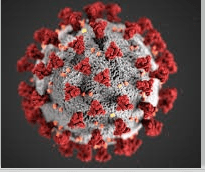
Basic Understandings of Coronavirus Disease 2019
Basic Understandings of Coronavirus Disease 2019- CORONAVIRUS DISEASE 2019 (COVID-19) is an infectious disease caused by severe acute respiratory syndrome coronavirus 2 (SARS-CoV-2).The disease was first identified in December 2019 in Wuhan, the capital of China’s Hubei province, and has since spread globally, resulting in the coronavirus pandemic.
[read more]
The World Health Organization (WHO) declared the coronavirus outbreak a Public Health Emergency of International Concern (PHEIC) on 30 January 2020 and a pandemic on 11 March 2020.
TRANSMISSION:
The virus is most contagious when people are symptomatic. While it is not entirely clear how easily the disease spreads, one person generally infects two to three others.
The virus survives for hours to days on surfaces. Specifically, the virus was found to be detectable for one day on cardboard, for up to three days on plastic and stainless steel and for up to four hours on 99% copper. This, however, varies based on the humidity and temperature.
Surfaces may be decontaminated with a number of solutions. Soap and detergent are also effective if correctly used.
COVID-19 virus is primarily transmitted between people droplet transmission which occurs when a person is in close contact (within 1 m) with someone who has respiratory symptoms (e.g., coughing or sneezing) and is therefore at risk of having his/her mucosae (mouth and nose) or conjunctiva (eyes) exposed to potentially infective respiratory droplets.
STAGES OF TRANSMISSION:
Stage 1: First appearance of the disease
It is the phase when the disease is just introduced, and positive cases begin to emerge for the very first time. The appearance of the disease is restricted to people with travel histories to the infected areas.
Stage 2: Local transmission
This stage is when the local transmission starts to develop. The virus spreads locally, through an individual who either has a travel history, or the one who has come in direct contact with an already infected person. This stage typically sees an infected person pass the virus onto his/her family, friends, neighbours, and people who tend to be in his/her close vicinity and locality. The virus transmission in this stage can be monitored by contact tracing, isolating people with symptoms, strict screening measures, social distancing, and lockdown efforts.
Stage 3: Community transmission
This is the stage where the community transmission starts to occur, making it difficult to trace the source of the infection spread. The infections are typically passed on in public. Moreover, individuals who don’t have a travel history to any infected ‘hotspots’, or who have had no known contact with any foreign source-person, also start to test positive. Once community transmission begins, it becomes difficult to stop the chain of transmission. As the disease pops-up in random individuals in a community, contact tracing and isolation becomes impossible and large-scale lockdowns become extremely important.
Stage 4: Widespread outbreak
In this fourth and final stage of transmission, there is a widespread outbreak—an epidemic—as the number of cases and deaths begin rapidly multiplying. In this stage, the disease becomes endemic, i.e. native to the population.
SIGNS AND SYMPTOMS:
Those infected with the virus may be asymptomatic or develop flu-like symptoms, including fever, cough, fatigue, and shortness of breath.
Emergency symptoms include difficulty breathing, persistent chest pain or pressure, confusion, difficulty waking and bluish face or lips; immediate medical attention is advised if these symptoms are present In some, the disease may progress to pneumonia, multi-organ failure and death.
As is common with infections, there is a delay between the moment when a person is infected with the virus and the time when they develop symptoms. This is called the incubation period. The incubation period for COVID-19 is typically five to six days but may range from two to 14 days.
DIAGNOSIS:
The WHO has published several testing protocols for the disease. The standard method of testing is real-time reverse transcription polymerase chain reaction (rRT-PCR). The test is typically done on respiratory samples. Results are generally available within a few hours to two days. Blood tests can be used, but these require two blood samples taken two weeks apart and the results have little immediate value.
There is another, more common type of rapid diagnostic test marketed for COVID-19- antibody test, a test that detects the presence of antibodies in the blood of people believed to have been infected with COVID-19. Antibodies are produced over days to weeks after infection with the virus.
Along with laboratory testing, chest CT scans may be helpful to diagnose COVID-19 in individuals with a high clinical suspicion of infection but is not recommended for routine screening.
These simple test kits are based either on detection of proteins from the COVID-19 virus in respiratory samples (e.g. sputum, throat swab) or detection, in blood or serum, of human antibodies generated in response to infection.
PREVENTION:

Social distancing is the best way to prevent the spread of infection i.e to avoid or limit contact with people who are showing symptoms of COVID-19 or any respiratory infection.
The next best thing you can do is practice good hygiene to prevent bacteria and viruses from spreading. Moreover, wearing cloth masks can help to slow the spread of coronavirus.
“Life imposes things on you that you can’t control, but you still have the choice of how you’re going to live through this.”
Note : This is just a basic understanding of the virus for awareness purpose , for more information and medical advise please contact concerned authority in our country. We recommend to follow government advisory in this regard. Browse Online Pharmacy , Health & Beauty
[/read]
